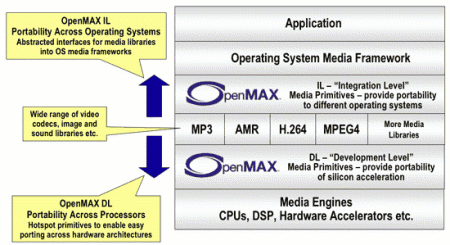Royalty-free streaming media spec released
Jan 4, 2006 — by LinuxDevices Staff — from the LinuxDevices Archive — 4 viewsA member-funded industry consortium has released the first of a three-part specification aimed at fostering embedded OS and architecture portability for streaming multimedia codecs and applications. The Khronos Group's royalty-free OpenMAX IL 1.0 specification defines a standardized interface for multimedia codecs implemented in hardware or software, the Group says.
Additionally, the Khronos Group has released details of its OpenMAX IL 1.0 Adopter's Program, including conformance tests. A sample OpenMAX IL implementation for Linux, contributed by Texas Instruments (TI), will become available in Q1, 2006, it says.
OpenMAX
OpenMAX IL (integration layer) is the first of three OpenMAX standard layers that together will “provide comprehensive streaming media codec and application portability by enabling accelerated multimedia components to be developed, integrated and programmed across multiple operating systems and silicon platforms,” the Khronos Group says.

OpenMAX aims to support a wide range of codecs
According to the Khronos Group, the OpenMAX IL API (application programming interface) defines a standardized media component interface “to enable developers and platform providers to integrate and communicate with multimedia codecs implemented in hardware or software.”
Other OpenMAX layers include:
- DL (development layer) — APIs aimed at helping codec developers create portable codecs, by providing a standardized set of primitive functionality across a range of computing platforms. Ratification and public release is expected in Q1, 2006
- AL (application layer) — An application-level API aimed at providing OS and architecture portability for streaming media applications. Expected before 2007.
OpenMAX IL was developed by a Khronos Working Group chaired by TI, with the support of member companies that include ARM, ATI Technologies, Beatnik, Broadcom, Emuzed, Fraunhofer, Freescale, Infineon, Intel, Motorola, Nokia, NVIDIA, Philips, SKY MobileMedia, Samsung, Sasken, Siemens, ST Microelectronics, and Symbian.
Khronos president Neil Trevett, also a VP of embedded content at Nvidia, stated, “OpenMAX has been developed to fulfill an urgent industry need with significant industry support from silicon and software vendors and OEMs. Nvidia is fully committed to deploying OpenMAX on its range of embedded GPUs.”
Avner Goren, director of cellular systems marketing for TI, stated, “[We] will be working closely with customers and partners in deployment of OpenMAX interfaces on OMAP and OMAP Vox [based] devices.”
Andrej Zdravkovic, senior director of software development at ATI, stated, “[We are] looking forward to deploying OpenMAX interfaces on [our] Imageon Media Processors.”
Jeremy Coop, chief sales officer of Beatnik, stated, “[We] will be supplying OpenMAX IL compliant implementations of our mobileBAE software audio engine. By delivering technology that meets the demands of OpenMAX IL, we are enabling handset manufacturers to reduce integration time.”
Mark Casey, GM of applications processors at Intel, stated, “[We plan] to release our OpenMAX IL implementation for Wireless MMX and MMX2 technology early this year, with OpenMAX DL releases later in the year.”
Tom Pollard, VP of marketing for Sky, stated, “[We are] supporting OpenMAX IL in our second generation SKY-MAP 2.0 mobile application software platform. When OpenMAX AL is ratified, we plan to also support this standard as part of our core strategy to maximize the portability of our software platforms.”
Availability
The OpenMAX IL 1.0 specification is available for download, here.
Additionally, the Khronos Group says it will deliver the first public OpenMAX demonstration at a media-only event at the Consumer Electronics Show (CES) in Las Vegas this week. The demonstration will feature OpenMAX IL 1.0 executing an MPEG-4 audio and video decode and display pipeline on a NVIDIA GoForce 3D GPU designed for mobile phones. Additional details can be found here.
This article was originally published on LinuxDevices.com and has been donated to the open source community by QuinStreet Inc. Please visit LinuxToday.com for up-to-date news and articles about Linux and open source.